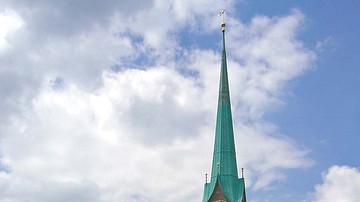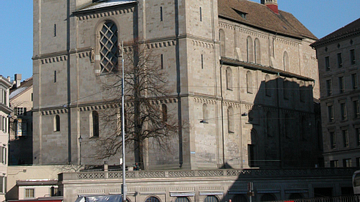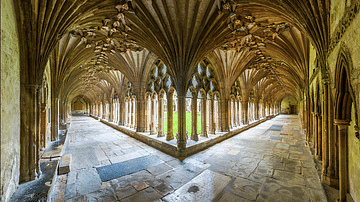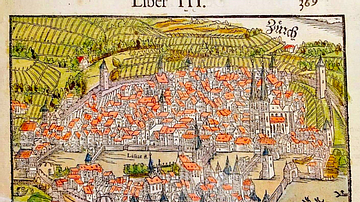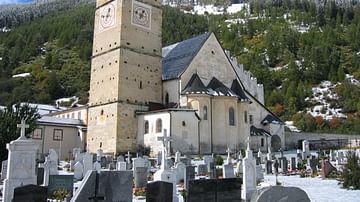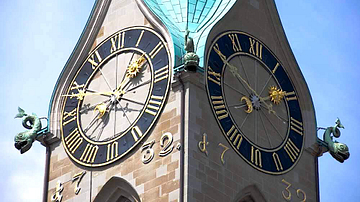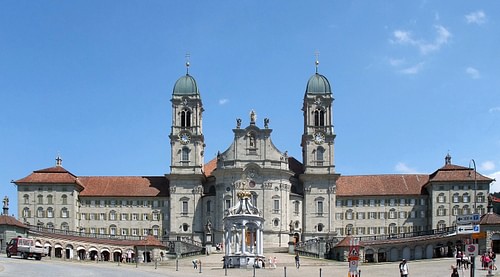
Einsiedeln Abbey and Monastery (German: Kloster Einsiedeln), located some 31 km (19 mi) southeast of Zürich at the foot of a hill in the town of Einsiedeln in Canton Schwyz, Switzerland, is the most important site of Roman Catholic pilgrimage in Switzerland. Founded by the Benedictine monk and hermit Saint Meinrad around c. 835 CE, Einsiedeln Abbey has been the site of Marian devotion in Switzerland for over a thousand years. In its heyday during the Middle Ages and Early Modern Era, Einsiedeln was a wealthy abbey patronized by the Habsburg dynasty, and an important station on the Way of St. James (Spanish: Camino de Santiago de Compostela). The Swiss reformer Ulrich Zwingli preached at Einsiedeln Abbey before he began his Protestant ministry at Zürich's Grossmünster, but the abbey escaped the ravages of the Protestant Reformation. Famed for its Black Madonna, which dates to the 15th century CE, Einsiedeln Abbey remains an important site of Catholic of pilgrimage in Europe. It is arguably the most impressive monastic structure in Switzerland.
Founding & Legends
According to Swiss tradition, Saint Meinrad (c. 800-861 CE) founded a hermitage at Einsiedeln Abbey around the year 835 CE. Meinrad had studied at the abbey school on the island of Reichenau in what is present-day Germany, and he subsequently became a monk and then a priest. After spending some further years at Reichenau and at the Benedictine priory at Benken within the vicinity of Lake Zürich, he established a small hermitage on the side of Etzel mountain. Legend states that Meinrad had been given a black statue of the Virgin Mary from Abbess Hildegard (828-856 CE) of Fraumunster Abbey in Zürich, which could perform miracles and other miraculous phenomena. (The current Madonna statue, however, dates from the 15th century CE.) The legend stuck, attracting the faithful to Meinrad's hermitage. Although thieves killed Saint Meinrad in 861 CE — the traditional date for his death is given as January 21st, which also serves as his feast day — two Swabian hermits based in Strasbourg, Benno (d. 940 CE) and Eberhard (890-958 CE), transformed the community of hermits at Einsiedeln into a Benedictine monastery around c. 934 CE.
Medieval & Early Modern History
Rededicated to “Our Lady of the Hermits,” Einsiedeln Abbey grew wealthy and received many imperial privileges from Holy Roman Emperors and local magnates. Holy Roman Emperor Otto I (r. 936-973 CE) was the first emperor to patronize the abbey continuously over the course of is reign, and the prestige of Einsiedeln's abbots gave them immense power in what is now present-day German-speaking Switzerland and the southern German state of Swabia. The abbots of Einsiedeln Abbey were styled as “princes of the empire” after 965 CE, and from the mid-10th century CE onward, Einsiedeln's abbots oversaw the founding of other religious houses throughout the region: Petershausen in Konstanz, Germany (983 CE), Muri Abbey in Canton Aargau, Switzerland (1027 CE), and Hirsau Abbey in Calw, Germany (1065 CE).
Einsiedeln and its dependencies became an independent principality by the order of Rudolf I (r. 1273-1291 CE) of Austria, who additionally initiated a prolonged period of Habsburg patronage. (This patronage extended well into the 18th century CE.) With the trust and recognition of Habsburg emperors and princes, Einsiedeln's abbots exercised spiritual and temporal authority over the lands and properties that fell under their jurisdiction. Einsiedeln Abbey became increasingly renown throughout the Middle Ages as a center of learning and culture, and many saints and scholars studied or resided at the abbey for extended periods of time. By the late Middle Ages, a position at Einsiedeln Abbey was so coveted that entry to the abbey's religious community was restricted to only the sons of the nobility.
Following the canonization of Meinrad as a saint in 1039 CE, Saint Meinrad's relics and remains were transferred from Reichenau to Einsiedeln, which greatly enhanced the abbey's importance as a place of worship and pilgrimage. The cell of Saint Meinrad evolved into the shrine of the Black Virgin, enticing thousands upon thousands of pilgrims from southern Germany, Alsace, Switzerland, and northern Italy to come to Einsiedeln every year. During the annual festival of Engelweih, which celebrated the consecration of a church at Einsiedeln by an angel, 400 confessors stood ready to address the needs of 130,000 pilgrims who were seeking a general indulgence in the jubilee year of 1466 CE. Many of Einsiedeln's medieval pilgrims traveled through Zürich en route to Santiago de Compostela in what is now present-day Spain.
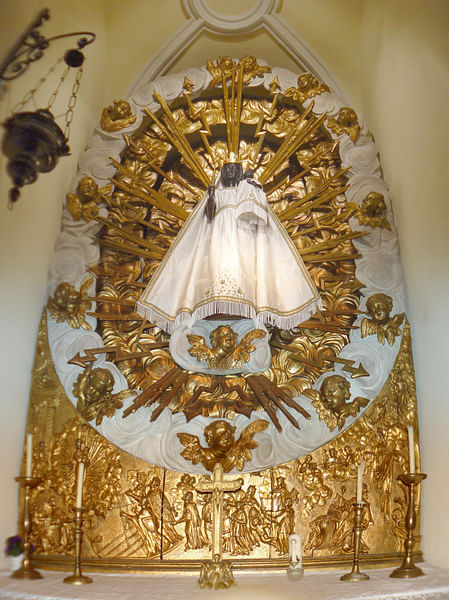
The relationship between Einsiedeln Abbey and Grossmunster Cathedral and Fraumunster Abbey in Zürich was close. Local magistrates in Zürich coordinated and organized yearly pilgrimages undertaken by Zürchers to Einsiedeln Abbey in the days following Pentecost. Officials meticulously recorded the names of those taking the pilgrimage, and 24 members of Zürich's clergy, drawn from Grossmünster, Fraumünster and St. Peter's Church, led the faithful 56 km (35 mi) along Lake Zürich to Einsiedeln. Between 1,500-1,800 Zürchers (out of a population of only 5,000) made the pilgrimage from year-to-year prior to the Protestant Reformation. These pilgrimages from Zürich ceased in the summer of 1524 CE at the height of the Protestant Reformation in Zürich.
Einsiedeln Abbey was still wealthy at the close of the Middle Ages, but its abbots had become lazy and corrupt, squandering much of the abbey's resources and tarnishing its good name. Curiously, Ulrich Zwingli (1484-1531 CE), who later led the Protestant Reformation in Zürich, worked as a preacher at Einsiedeln from 1516-1518 CE. His time at the abbey no doubt colored his subsequent opinions on the Catholic clergy and pilgrimages, but ironically, it was at Einsiedeln Abbey where many of Zürich's elite and later supporters of Zwingli's reforms heard him preach for the first time during the annual Engelweih. During the Protestant Reformation, Einsiedeln Abbey escaped the ravages of iconoclasm and Canton Schwyz remained Catholic. Louis Blarer, an ordinary monk from St. Gallen who acted as Einsiedeln's abbot from 1526-1544 CE, succeeded in safeguarding Einsiedeln's autonomy and in restoring a stricter observance of Benedictine rules and rituals. He removed the restrictions of entry into the abbey as well. Two other abbots - Joachim Eichhorn (1544-1569) and Augustine (1600-1629) - continued Blarer's legacy of consolidation during the eras of the Counter-Reformation and the Thirty Years' War. Einsiedeln Abbey prospered in the 18th century CE, and the millenary of Saint Meinrad was celebrated in 1861 CE with much fanfare.
Architecture & Miscellany
The earliest ecclesiastical structure and thus precursor to Einsiedeln Abbey was a church built on the site of the cell occupied by Saint Meinrad before his murder by thieves in 861 CE. In the following century, Otto I and Duchess Regelinda of Swabia (890-958 CE) founded a monastery at Einsiedeln in 935 CE. Einsiedeln's main road intersects the western side of a large town square which is where the abbey church stands today. Einsiedeln Abbey's façade faces a large, semicircular courtyard, which contains a fountain in honor of the Virgin Mary.
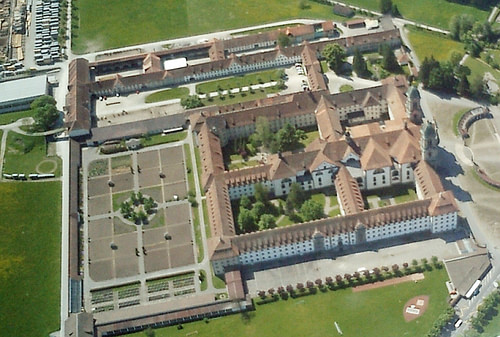
This structure was harmed by several burnings, and Einsiedeln Abbey appears very different today than it did in the Middle Ages. The abbey church, entirely reconstructed and refurbished in the Vorarlberg Baroque style between 1719-1735 CE, has two towers that flank the church's façade. The church is an impressive 113 m (370 ft), the width of the nave measures 41 m (131 ft), and the height of its dome to its lantern is 37 m (118 ft). Frescoes and stuccos can be found across the abbey church, giving the building an elegant and graceful feel. Near the entrance of the abbey church, one finds the Chapel of Grace (German: Gnadenkapelle), which is Neoclassical in its design and contains the venerated statue of the Black Madonna. This is also where the reliquary of Saint Meinrad is located.
55 monks teach at the Einsiedeln Abbey School, which registrars about 350 students. These monks also serve in local parishes, and administer to the spiritual needs of pilgrims. Between 150,000 to 200,000 Catholic pilgrims visit Einsiedeln annually. Einsiedeln Abbey also encompasses an elaborate monastic complex and library, a diocese school, a wine cellar that produces the abbey's own wine, ten workshops, and stables for the monastery's own breed of horses.


